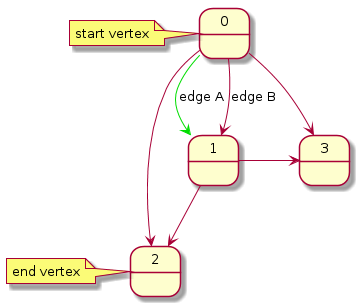I have also found that when the root vertex has more than one (non-parallel) edge, that only one of these edges result in a path.
My test case:
// Create the following graph:
// 2 ⮀ 0
// ⭨ ↓ ⭨ 3
// 1 ⭧
var graph = new AdjacencyGraph<int, Edge<int>>();
graph.AddVerticesAndEdge(new Edge<int>(0, 1));
graph.AddVerticesAndEdge(new Edge<int>(0, 2));
graph.AddVerticesAndEdge(new Edge<int>(0, 3));
graph.AddVerticesAndEdge(new Edge<int>(2, 0));
graph.AddVerticesAndEdge(new Edge<int>(2, 1));
graph.AddVerticesAndEdge(new Edge<int>(1, 3));
// Set source and destination
var source = 2;
var destination = 3;
var algo = new EdgeDepthFirstSearchAlgorithm<int, Edge<int>>(graph);
var observer = new EdgePredecessorRecorderObserver<int, Edge<int>>();
using (observer.Attach(algo))
{
algo.Compute(source);
}
var listOfPaths = observer.AllPaths()
.Where(x => x.Last().Target == destination)
.ToList();
// Check
listOfPaths.Should().HaveCount(3, because: "There are 3 paths from node 2 to node 3");
listOfPaths.Should().ContainEquivalentOf(new List<Edge<int>> { edge21, edge13 }, because: "One path is from 2 to 1 to 3");
listOfPaths.Should().ContainEquivalentOf(new List<Edge<int>> { edge20, edge03 }, because: "One path is from 2 to 0 to 3");
listOfPaths.Should().ContainEquivalentOf(new List<Edge<int>> { edge20, edge01, edge13 }, because: "One path is from 2 to 0 to 1 to 3");Expected outcome is 3 paths:
- 2 -> 0 -> 3
- 2 -> 0 -> 1 -> 3
- 2 -> 1 -> 3
Instead the result is 2 paths:
- 2 -> 0 -> 3
- 2 -> 0 -> 1 -> 3
So the path option that includes the 2 -> 1 edge is not found.
Considering the following graph
For this graph we would like to know all possible paths between two nodes. So for the example below the resulting paths between nodes 0 and 2 would be:
The code to accomplish this is:
However only 2 paths are found, not finding the one that has edge B:
Would we add a parallel edge between nodes 1 and 2, then indeed 3 paths are found.